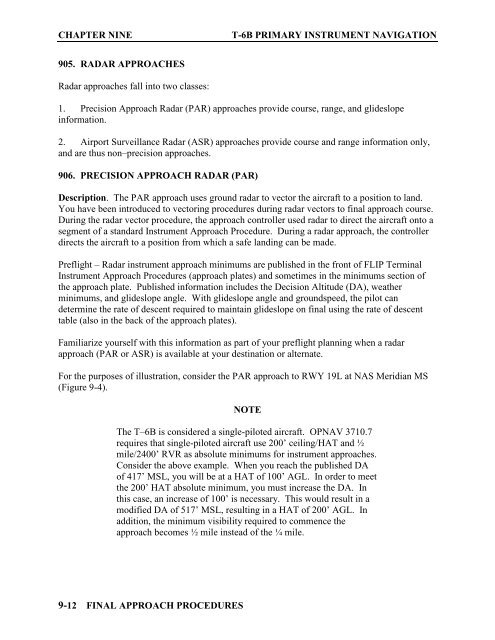Flight Training Instruction - Cnatra - U.S. Navy
Flight Training Instruction - Cnatra - U.S. Navy
Flight Training Instruction - Cnatra - U.S. Navy
Create successful ePaper yourself
Turn your PDF publications into a flip-book with our unique Google optimized e-Paper software.
CHAPTER NINE T-6B PRIMARY INSTRUMENT NAVIGATION<br />
905. RADAR APPROACHES<br />
Radar approaches fall into two classes:<br />
1. Precision Approach Radar (PAR) approaches provide course, range, and glideslope<br />
information.<br />
2. Airport Surveillance Radar (ASR) approaches provide course and range information only,<br />
and are thus non–precision approaches.<br />
906. PRECISION APPROACH RADAR (PAR)<br />
Description. The PAR approach uses ground radar to vector the aircraft to a position to land.<br />
You have been introduced to vectoring procedures during radar vectors to final approach course.<br />
During the radar vector procedure, the approach controller used radar to direct the aircraft onto a<br />
segment of a standard Instrument Approach Procedure. During a radar approach, the controller<br />
directs the aircraft to a position from which a safe landing can be made.<br />
Preflight – Radar instrument approach minimums are published in the front of FLIP Terminal<br />
Instrument Approach Procedures (approach plates) and sometimes in the minimums section of<br />
the approach plate. Published information includes the Decision Altitude (DA), weather<br />
minimums, and glideslope angle. With glideslope angle and groundspeed, the pilot can<br />
determine the rate of descent required to maintain glideslope on final using the rate of descent<br />
table (also in the back of the approach plates).<br />
Familiarize yourself with this information as part of your preflight planning when a radar<br />
approach (PAR or ASR) is available at your destination or alternate.<br />
For the purposes of illustration, consider the PAR approach to RWY 19L at NAS Meridian MS<br />
(Figure 9-4).<br />
9-12 FINAL APPROACH PROCEDURES<br />
NOTE<br />
The T–6B is considered a single-piloted aircraft. OPNAV 3710.7<br />
requires that single-piloted aircraft use 200’ ceiling/HAT and ½<br />
mile/2400’ RVR as absolute minimums for instrument approaches.<br />
Consider the above example. When you reach the published DA<br />
of 417’ MSL, you will be at a HAT of 100’ AGL. In order to meet<br />
the 200’ HAT absolute minimum, you must increase the DA. In<br />
this case, an increase of 100’ is necessary. This would result in a<br />
modified DA of 517’ MSL, resulting in a HAT of 200’ AGL. In<br />
addition, the minimum visibility required to commence the<br />
approach becomes ½ mile instead of the ¼ mile.
















